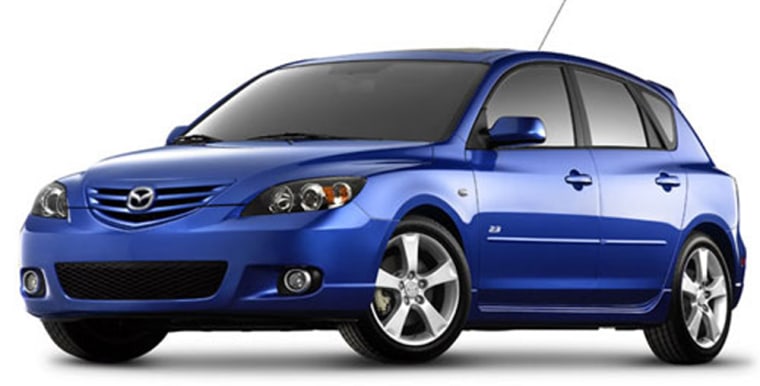It has come to this: even Texans are having second thoughts about their big trucks. In Fort Worth, deep in the heart of truck country, the Mortiz Kia used-car lot is packed with big sport-utes and minivans that buyers have traded in for cars that look pint-size by comparison, including the Sportage small SUV and Spectra compact.
During the big-SUV boom, many buyers stretched their monthly budgets to lasso one of the monsters. But as gas prices jumped 50 percent, sending the cost of filling up the tank of a large SUV north of $70, those gigantic gas-eaters stopped looking so alluring. Customers, says Kia new-car sales manager David Benker, "want something smaller to drive to work every day."
Cool and cute
America is still a far cry from Europe, where the family car is often a compact. In the U.S., downsizing often means trading a huge SUV for a slightly smaller one. Still, for those willing to truly trade down, the good news is that a fresh crop of little cars is making small cool again.
While soaring prices at the pump are probably the single most important factor drawing buyers back, small cars are also benefiting from smart designs and youthful, edgy marketing.
The boldly styled Mazda 3 is one of the hottest cars on the market, with sales up 45 percent this year. High-end small autos such as the Mini Cooper convertible and the all-new Audi A3 — as well as dirt-cheap Korean-made Chevys, Kias, and Hyundais — pushed sales of small cars up 23 percent in September. They now make up 18 percent of the U.S. market, a major leap from the 13.6 percent they claimed a year earlier, according to Edmunds.com, a Santa Monica, Calif.-based auto research firm.
No more econoboxes
At the same time, car buyers are abandoning SUVs in droves. With sales off 33 percent in September, sport-utes grabbed just 14.5 percent of the U.S. market, down from 19.4 percent a year ago. Is this the big shift away from SUVs that has long been predicted? Tom Libby, an analyst with J.D. Power & Associates' Power Information Network, says defections from larger vehicles to compacts picked up last month.
Yet experts like Libby believe gas prices will have to stay at today's levels or even rise higher to force a wholesale change in what Americans buy. However significant the change, one thing is clear: Auto makers are moving swiftly to put renewed focus on their small-car offerings.
Gone are the days of churning out econoboxes. Now the push is on to add splashy styling and make downsized cars roomier and more fun to drive. Carmakers are betting that, by offering up sporty compacts, small wagons, and crossovers, they can get better prices and, ultimately, higher margins.
Doing it right
It's not surprising, then, that fleets of diminutive new vehicles will be rolling into dealers' lots before too long. Chrysler Group will replace its old Neon compact with a trio of small, spiffy Jeep and Dodge entries starting next year. BMW plans to bring its new sporty compact 1 Series to the U.S. and launch a roomier Mini in 2007.
Ford is toying with some new compacts, and Nissan will launch the subcompact Versa next June. Says Johan de Nysschen, executive vice-president of Audi of America: "Companies are trying to build good cars that just happen to be small."
It has taken awhile, but other carmakers are finally catching on to what Chrysler and BMW proved several years ago: Done right, small cars can make money. The PT Cruiser, built on the underpinnings of the Neon, was a hit when it launched in early 2000. The Mini proved that stylish compacts are no fluke — and that they can sell for as much as $30,000.
Aggressive styling
The PT Cruiser's success prompted General Motors Vice-Chairman Robert A. Lutz to develop the Chevrolet HHR, a rival retro compact wagon which hit the market in July. Lutz, who came up with the PT Cruiser back in his Chrysler days, is boasting strong initial sales numbers, saying the HHR is on a pace to beat its 60,000-a-year target. Insiders say GM dumped plenty into rental fleets. But Lutz claims GM sees enough demand to double production. "There used to be a view that no one cared about small cars, but that's a defeatist's strategy," Lutz says.
To make their pint-size offerings more profitable — and to hedge against continued stratospheric fuel prices — auto makers are putting more resources into small-car development. Take Chrysler, which is betting its trio of more aggressively styled cars will sell more for their fashion than their fuel economy.
Next year the Neon plant in Belvedere, Ill., will stop making tinny boxes and start building three new models: the Dodge Caliber, Jeep Patriot, and Jeep Compass. Chrysler figures all three can fetch fatter prices than the Neon ever did. "Conventional wisdom says you can't make money selling small cars," says Jeep Vice-President Jeff Bell. "We're defying conventional wisdom."
Cheap entries
Some companies even think subcompacts can thrive in the U.S. Jed Connelly, Nissan North America's senior vice-president for sales, says the company's Versa subcompact, which is smaller than the compact Nissan Sentra and is built on the frame of the European Renault Clio, should pull in buyers who have been looking at used cars. Honda, just launching its new Civic, will make a similar play with the Fit hatchback. Toyota also will bring out the Yaris subcompact. All three will sell in the $13,000 range.
Cars like the Versa and Fit may only sell in big numbers if gasoline prices stay above $3 a gallon well into next year. "There seems to be some growth in this market," says Connelly. "I don't know if it will last." But other carmakers are trading on style -- and that will sell no matter what.
